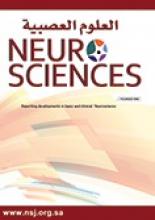To the Editor
We have read with interest the distinguished study by Al-Qudah et al on the type and etiology of pediatric epilepsy in Jordan.1 Based on the International League Against Epilepsy (ILAE) 2010 classification, the authors found that 90.2% of patients had one seizure type, (53%) of this type were focal seizures followed by generalized seizures (41.5%) and spasms (5.5%). Distinctive constellations were found in 1.7% of patients. Benign epilepsies with centrotemporal spikes were the most common electro-clinical syndromes (27.1%). Epilepsies attributed to structural-metabolic causes were documented in 41.9% of patients, unknown causes (40.4%), and genetic causes in (17.7%) of patients. Most common causes of structural-metabolic group were due to perinatal insults (32%) and most common causes of the genetic group were the presumed genetic electro-clinical syndromes (93.1%).1 I presume that these results ought to be cautiously taken owing to the presence of the following methodological limitation. The employed ILAE in Al-Qudah et al’s study dates back to 2010. It has been criticized with a need to proposes a radical change with the elimination of classical concepts, without maintaining the useful elements and modifying only the parts that reflect obsolete concepts in the light of current scientific evidence.2 Unnecessary confusion has been generated by, for example, eliminating the division between focal and generalized epilepsies, but keeping the concept of focal and generalized epileptic seizures or by proposing a classification that mixes different approaches, electro-clinical criteria, etiology, and so on.2 Recently, ILAE 2017 classification is launched. It is operational (practical) and based on the 1981 classification, extended in 2010. It involves the following changes: “partial” becomes “focal”; awareness is used as a classifier of focal seizures; the terms dyscognitive, simple partial, complex partial, psychic, and secondarily generalized are eliminated; new focal seizure types include automatisms, behavior arrest, hyperkinetic, autonomic, cognitive, and emotional; atonic, clonic, epileptic spasms, myoclonic, and tonic seizures can be of either focal or generalized onset; focal to bilateral tonic-clonic seizure replaces secondarily generalized seizure; new generalized seizure types are absence with eyelid myoclonia, myoclonic absence, myoclonic-atonic, myoclonic-tonic-clonic; and finally seizures of unknown onset may have features that can still be classified.3 This new classification does not represent a radical change, but it allows more flexibility and transparency in naming epilepsy types.3 The clinical implication of ILEA 2017 classification in certain populations showed a higher precision of diagnoses, but at the expense of leaving more epilepsies classifiable only at the mode of onset level.4 I presume that if Al-Qudah et al1 employed ILAE 2017 classification in their study, different results might be obtained.
Reply from the Author
Prof. Al-Mendalawi comments on methodological limitation of ILAE 2010 report used in our published article in Neurosiences journal.1
The Report of the ILAE Commission on Classification and Terminology, 2005–2009 has attracted a lot of debate regarding its value compared to the ones previously reported,5 but it took about 7 years to publish the new Operational classification of seizure types by ILAE 2017.3 Many distinguished studies have been published using the ILAE 2010 report and our study was carried out in the period 2013-2016, where the report of ILAE 2010 used and got published in 2017.6-7 Prof. Al-Mendalawi said: “I presume that if Al-Qudah et al1 employed ILAE 2017 classification in their study, different results might be obtained”. That is true, but looks like saying if ILAE 1981 classification was employed different results might be also, obtained. I presume what will have the last word in the epilepsy classification, etiology, and terminology are the advances in the fields of neuroimaging, neurophysiology, genomic technology molecular biology and the better understanding of epilepsy in the future. Epilepsy has been a challenging dynamic issue for the scientists and will remain so.
Abdelkarim A. Al-Qudah,
Department of Pediatrics, Faculty of Medicine, University of Jordan, Amman, Jordan.
- Copyright: © Neurosciences
Neurosciences is an Open Access journal and articles published are distributed under the terms of the Creative Commons Attribution-NonCommercial License (CC BY-NC). Readers may copy, distribute, and display the work for non-commercial purposes with the proper citation of the original work.






